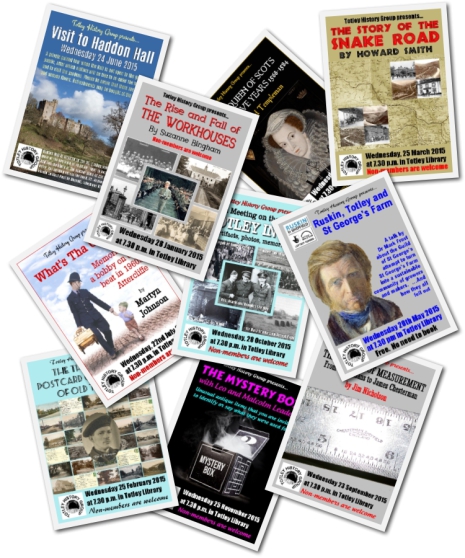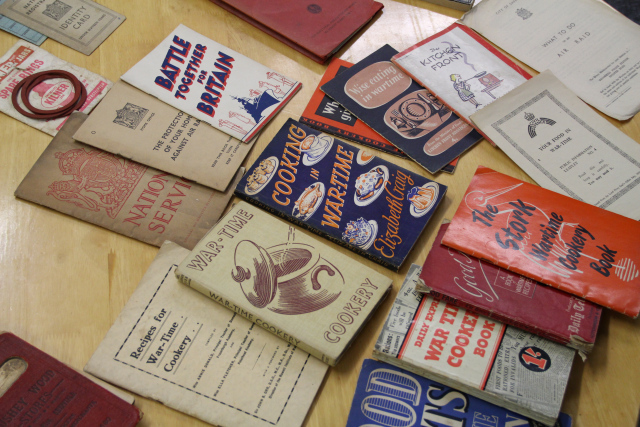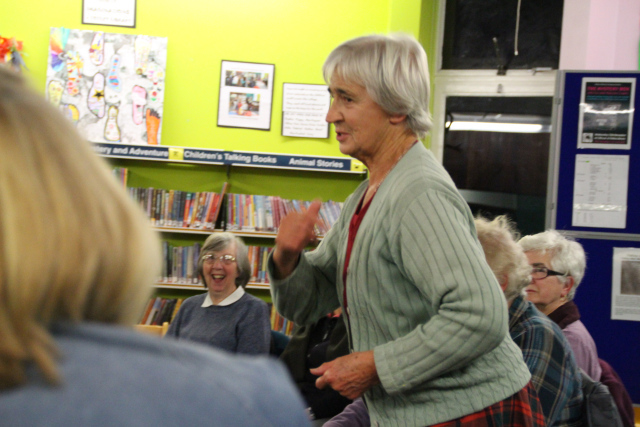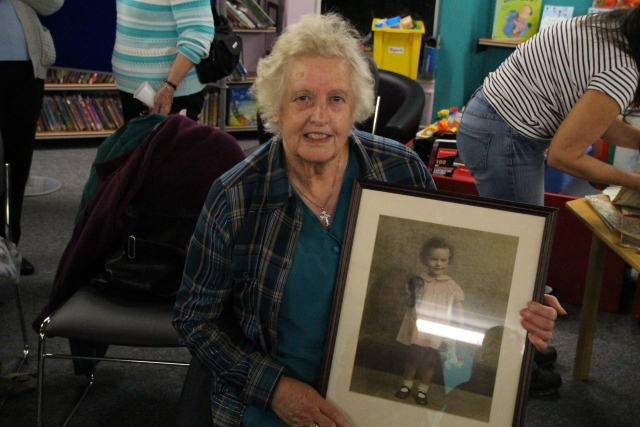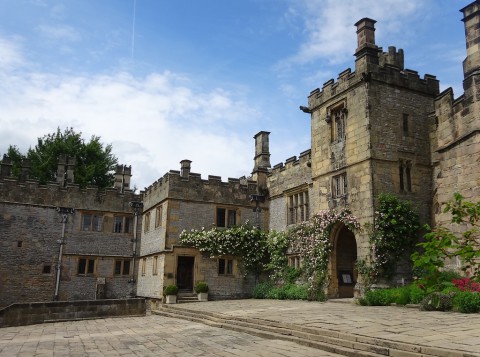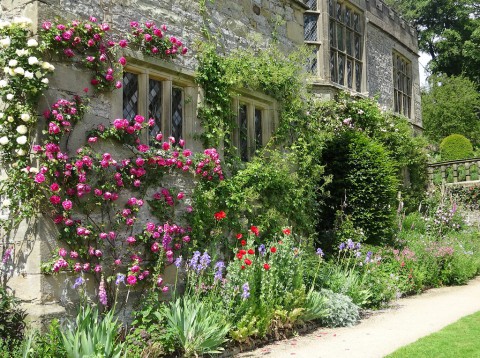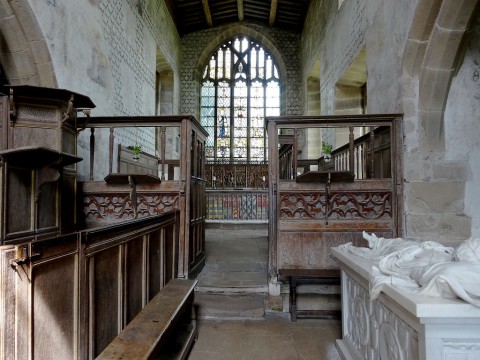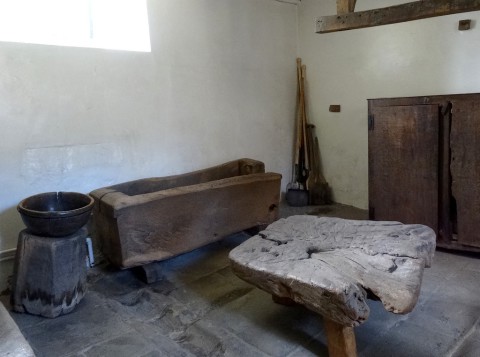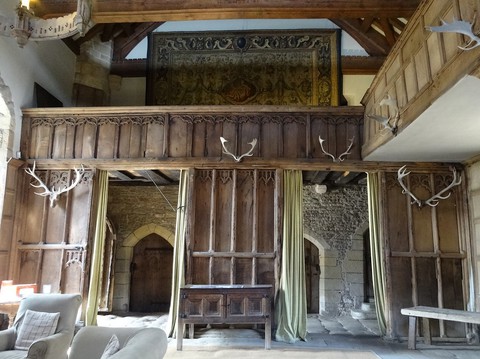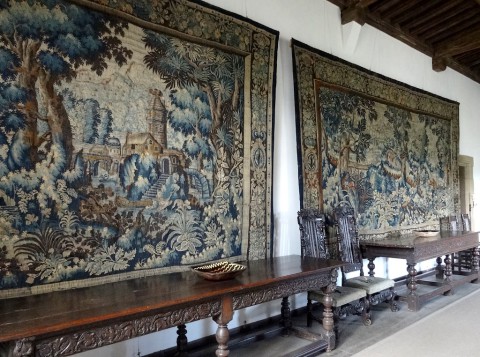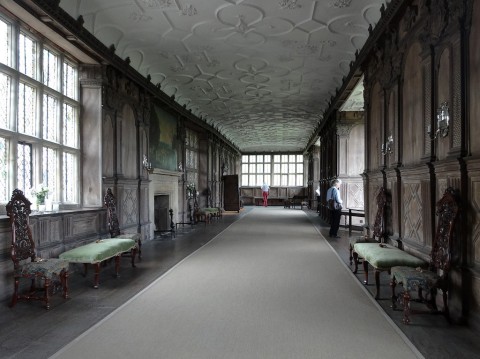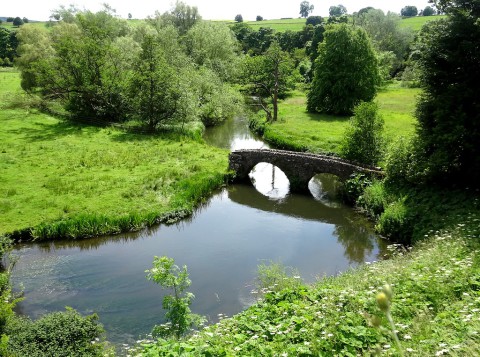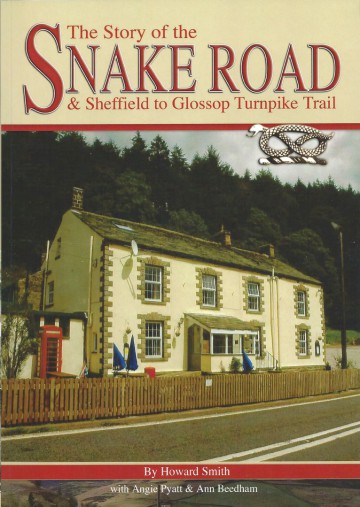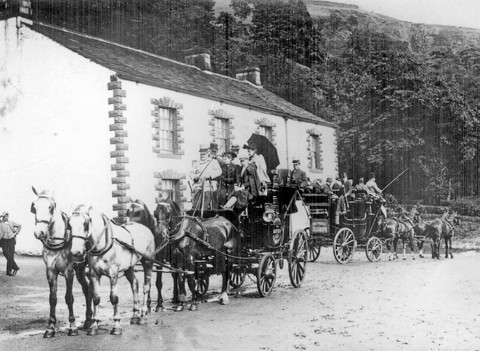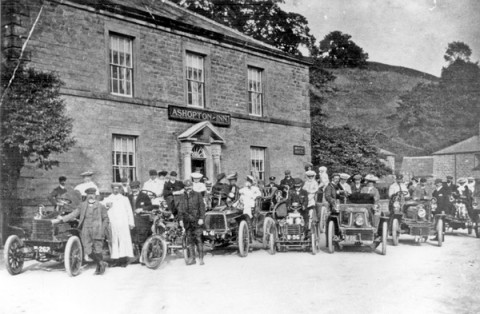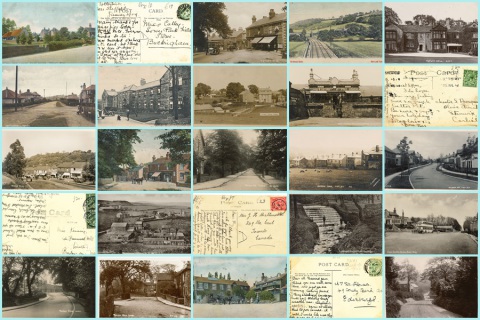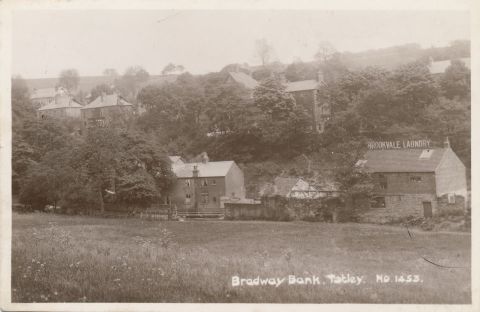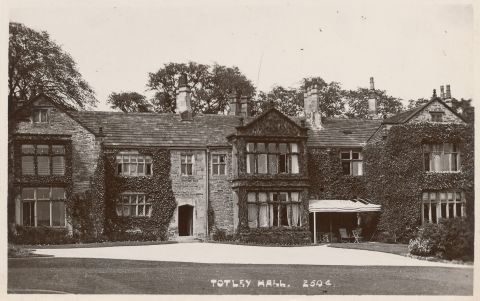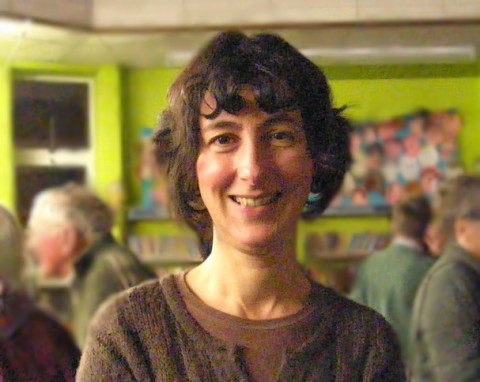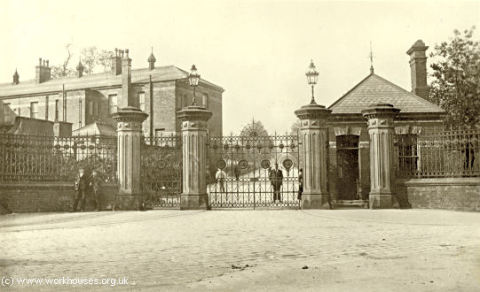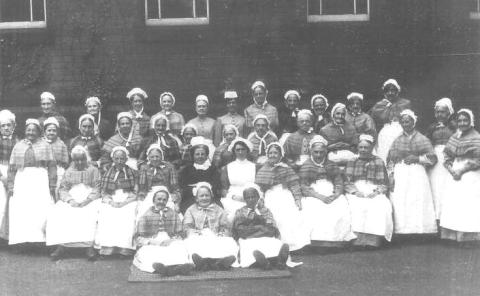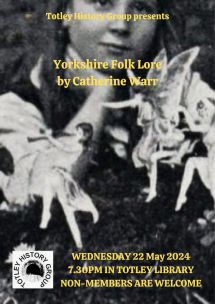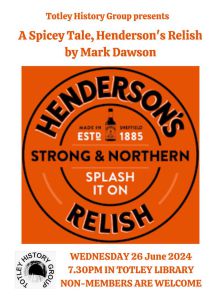Meetings in 2015
"If I’d remembered the plumber’s money I wouldn’t be here today”- Totley remembers World War Two
BY FINOLA FITZPATRICK, 29 OCTOBER 2015
Totley residents shared their memories of World War Two in a special open meeting held at Totley library last night.
Organised by the Totley History Group, local people came along with World War Two memorabilia and important stories to tell.
One such person is 80-year-old Maevis Roadhouse, who would not be here today if she had remembered the plumber’s money..
She said: “One day I was being sent up to do the shopping by my mother, and at that point bread wasn’t rationed so if you got up there quick you could get two loaves.
“But halfway up the road my mother called out, ‘you haven’t got the money for the plumber.’ So I went back, started going back up the road again towards the shops, when I heard this enormous bang.
“And blow me, when I got up to the village there were no shops, and no plumber’s house either. So if I had remembered the plumber’s money, I wouldn’t be here today.”
Silence fell in the room, but didn’t last long as Maevis said, “As they said in the war, should I go and make everyone a cup of tea?”
Ann Brown, 79, brought in a photograph close to her heart, and told us the story behind it.
She said: “I remember I was four years old when there was an air raid.
“Myself and my family had a choice between two shelters, and we were persuaded to go into one.
“We went in the shelter at the bottom of the street instead of the top, which was fortunate because the top shelter was a direct hit, and twelve people died.
“During the course of the night, my father was an ARP warden and he kept going out to see what was happening, although on the whole he stayed with us.
“He saw our row of houses on fire. The main problem with the fires is that they’d been set off by the incendiaries and they couldn’t put them out.
“The mains had been hit and there was water everywhere, but it was of no use.
“There was no pressure on the fire and we had to let the fires burn out themselves. There was nothing we could do about it.
“My father went back into my house and the only thing he rescued was this photo of me taken just months before. Everything else was lost.
“At 7am the air raid was over, and we went to the school nearby to be sorted out. We realised that we could go somewhere.
“We could go to Totley where Grandma lived. In any crisis she was there, and we walked from the moor in Sheffield through all the damage and everything on fire, along Abbeydale Road carrying this picture and nothing else.”
Dorothy Prosser, Chair of the Totley History Group, said: “We organised this event because it so important that we hear memories of World War Two and share them. By running events like this, we keep these memories alive for many generations to come.
Courtesy of the author, Finola Fitzpatrick, at Ingest South West
Visit to Haddon Hall
24 June 2015
On Midsummer's Day a group of 18 people met at the entrance to Haddon Hall for Totley History Group's summer outing - a private guided tour of Haddon Hall in Derbyshire. It was a beautiful morning with clear skies and warm sunshine.
Our guide took us into the lovely lower courtyard where she gave us a brief history of Haddon. A house and chapel were built on the site around 1150. It remained in the Vernon family until 1567. It passed into the Manners family when it was inherited by Dorothy Vernon who married Sir John Manners and it remains in the hands of the Manners family to this day.
Over the next four centuries there were additions and alterations but the Hall as we see it today is unaltered since 1703 when Sir John Manners was created 1st Duke of Rutland and the family moved to Belvoir Castle. Haddon remained unoccupied for 200 years although it was never allowed to fall into disrepair. In the early 20th century, the 9th Duke and Duchess began the extensive restoration which still continues. The 9th Duchess was also responsible for the beautiful gardens.
The tour began in the chapel, part of which dates from the 12th century and none of which is later than 1624, the date carved on one of the roof beams. There are traces of medieval frescoes on the walls including one of St. Christopher.
From there our guide took us into the house and into the wonderful Tudor kitchen which is one of the finest examples in the country. The kitchen is made up of several rooms, in addition to the main kitchen with its two huge fireplaces. There is a room with a bread oven, a butchery with a large salting trough made from a single hollowed out tree trunk, a milk larder and the steward's room among them. The main kitchen also has a stone water trough fed by a spring. It is divided into three to hold water of varying degrees of cleanliness.
Our next stop was the Great Hall with its Minstrels' Gallery. In the 14th century this would have been the main living space and both family and servants would have eaten and slept there. From the 15th century, the family had more privacy and ate their meals in the Great Chamber and used the Parlour as a sitting room. The Great Hall then became a place for entertaining guests and became known as the Banqueting Hall.
The Parlour has some wonderful carving on the wood panelling and a lovely plaster ceiling decorated with the Tudor rose and Talbot dog. The Talbot dog is the symbol of the Earls of Shrewsbury and is there in recognition of the marriage of Sir Henry Vernon to Anne Talbot, daughter of the 2nd Earl of Shrewsbury, around 1465. The family still use the Parlour as a dining room. Above the Parlour is the Great Chamber which has some fine 17th century tapestries hanging on the walls.
After visiting the Earl's Apartment we went into the lovely Long Gallery. This was used for indoor exercise when the weather was too cold or wet to go outside. It was used for balls and also by the ladies of the house to sit and do needlework.
The tour ended here and we were then free to explore the house and gardens at our leisure and also to have some lunch. Many of us chose to eat outside before continuing to look round at our own pace. The gardens are lovely at this time of year and apart from all the roses and flower beds there are some superb views over the surrounding countryside which is all part of the Haddon Estate. It was a most enjoyable and successful day out.
Mary Queen of Scots, the captive years 1568-1584
22 April 2015
We had a very interesting talk about "Mary Queen of Scots, the captive years 1568 to 1584", by David Templeman.
Mary arrived in England in May 1568 from Scotland; she had fled in fear of her life as she had just lost the battle for Scotland. It was a dangerous option for her to come to England as England was a Protestant country, however, Queen Elizabeth I had promised to help her. Mary went to Carlisle Castle and shortly after to Bolton Castle where she was confined as a house guest.
Mary had arrived in England to enlist Elizabeth’s help to regain Scotland. Mary was the lead suspect in the murder of Lord Darnley, however, Elizabeth advised that she could not help her but she could arrange for a court to hear her case. This was arranged in York in September, however, Mary couldn’t attend. On the first day the protestant lawyer produced some letters purporting to be love letters from her third husband who she had married three months after Lord Darnley’s murder, there were no dates on them, they were copies, if they were genuine Mary would be found guilty. The court case dragged on and moved to several other courts, Elizabeth asked for it to be wound up and so Mary’s name was not cleared.
Mary loved sport, like horse riding, the first lady recorded to play golf, played crochet, long bow. She was the cousin of Queen Elizabeth, so they were rivals and also related.
Elizabeth had to consider what to do with Mary long term, to help her to regain Scotland was a non-starter and to send her to France or Spain which were Catholic empires was not an option as they may help her so it was decided to keep her in England and appoint a custodian for her, the 6th Earl of Shrewsbury.
Mary’s imprisonment commenced on 4 February 1569, aged 27, at Tutbury Castle, she was kept a prisoner but as a queen with a working court. However, Mary was used to the lovely palaces such as Versaille, and Tutbury was part derelict, surrounded by bogs and smelly marshs and within three weeks she became ill.
She was therefore moved to Wingfield Manor in April 1569 and within two months of her arrival here both Mary and her custodian George Talbot nearly died, there was a large number of people living here (around 240) in a confined space, therefore lots of disease. She often went to Chatsworth from here whilst her apartments were cleansed and in May 1570 Mary arrived in Chatsworth to stay and then later that year in November went to Sheffield Castle the fourth largest medieval castle in England, she stayed here for 14 years.
Mary was involved in plots with the Northern Earls and with Spain, this latest plot led to Mary being arrested for high treason but Elizabeth refused to have her sent to London Tower so instead she was sent to Sheffield Castle. Mary had had a lovely time at Chatsworth with its surroundings but now at Sheffield her staff were reduced from 50 people to 16 and the only outdoor exercise was walking in the courtyard, this went on for years and had repercussions on Mary’s health. Mary had several escape attempts at Wingfield, Tutbury and Chatsworth, they were well planned, however, Mary refused them as she wanted the throne of England. She was taken to Sheffield as she was guaranteed more security here. Whilst staying at Sheffield Castle she frequently went to Sheffield Manor Lodge whilst the Castle was cleansed, the lodge was in the middle of a large deer park where deer were hunted.
Whilst being held capture Mary read and produced embroidery, a lot has survived. Mary liked Buxton for its waters that eased her ailments. She also went to Worksop Manor twice, this had 550 rooms and was a leading manor house, unfortunately, due to a candle fire it was later destroyed.
Mary’s health deteriorated at Sheffield Castle, she fell off a horse and damaged her back and developed a stoop. She also contracted rheumatic fever and was then hardly able to walk at the age of 42 years old.
Her final journey after the Throckmorton plot in 1583 and the break up of the Shrewsbury marriage was to Chortley Manor in Staffordshire. She then became involved in the Babington Plot where she was tried and executed.
The Story of the Snake Road
25 March 2015
On the evening of Wednesday 25 March, Howard Smith gave us a great talk on the making of the Snake Road, the A57 from Sheffield to Glossop.
Before the 1850s goods were transported on the back of horses. There were lots of benefits of moving goods via waggons and wheels which required turnpike roads to be built. In 1756 the first one was built from Sheffield, Chesterfield to Derby and then a network of roads began to be built. There were two routes to Manchester, one from Barnsley which later became the A61, and the southerly Hope Valley route. This kept being modified with the Winnatts Pass being opened via Mam Tor which is now closed.
Why was a third route needed? Around 1812 the American markets for Sheffield cutlery were affected by the war between America and Britain and there was an embargo on buying products. 6,000 people were employed in Sheffield for the supply of the American markets for edge tools, knives, nails etc. The war ended and there was a backlog of orders, Sheffield was desperate to cash in on this and it was decided to have a new road to speed up the journey times for getting goods to Liverpool via Manchester to be shipped to the United States. The area from Sheffield to Glossop had no setttlements and unusually the road was completely new and designed on paper rather than being an upgrade of an existing trackway. This is why we see some long straight stretches which is unusual for a road layout. £2,500 was required to fund its building and this was provided by the Dukes of Devonshire and Norfolk who owned the majority of the land. The surveyor was William Fairbank.
In 1821 the new turnpike was opened, it had taken 3 years to build. Normally by law the width of the actual road was 18 feet but it was 60 feet wide in total to provide grass verges on either side for people with horses, these verges were kept clear of obstructions so there were no hiding places for the highwaymen. However, in the case of the Snake Road this wasn’t possible due to the steep terrain. The road was cut into the hillside like a terrace.
Steep gradients were avoided because if the gradient was over 1 in 9 an extra horse had to be provided with a lad until the road levelled out, this was extra expense. There is one steep part near the summit and this is 1 in 10!
Gangs of men from Sheffield and Glossop were employed and they met at the River Derwent, they used picks, spades and wheelbarrows, it must have been very remote and hard work for them.
Toll charges were collected at the toll cottages where the charges had to be displayed outside on a board, these included the costs for moving the various types of animals and the numbers of them. At the end of the hill before Glossop the toll house still exists though it is now privately owned. The windows often had a slant to them so that the tollkeeper could see the traffic approaching from either direction.
The inns on the road provided food, drink and accommodation and the innkeepers also ran the stage coaches and provided stabling for the horses. The Norfolk Arms, Surrey Inn and Ashopton Inn are now gone but The Snake Pass Inn is still in existence.
There was great excitement when the Snake Road opened and the local press said it had cut down journey times and was a fine levelled road. The freight wagons travelled at 2.5 miles per hour and these replaced the packhorses and therefore reduced costs. A journey that once took 3 days now only took one day.
At this time flying wagons were used which went at 3 miles per hour, this was possible as the horses were changed and rested at the various inns on the road, using these people could now get to London in 4 days rather than a week. Stage coaches travelled at 8-9 miles per an hour and these also changed their horses at regular intervals. The Royal Mail coaches were the finest transport and fast, they had armed guards and travelled at night when there were no animals being transported on the roads. By law everyone had to move out of their way and tollkeepers had to have their gate open ready for them to pass through. A horn was used to notify of their arrival, they travelled at 12 miles per hour. Passenger coaches were also used, these had a crew of two and carried 15 passengers both inside and up on top in the open.
However, the road was financially a failure. Many of the people were put off using it as the moors were a threatening environment and a lot of people stuck to the route they knew where they had existing arrangements with innkeepers. The sailing ships took weeks to get the United States so a few hours saving did not make much difference to them. The bad weather during winter and frequent landslips also contributed to its lack of use. Also, not many people needed to get to Glossop, therefore, all these factors meant that not enough money was taken in tolls. It only survived as the two Dukes kept providing the money.
25 February 2015
On the evening of 25 February, Christine Shimell facilitated a computer slideshow of postcards from the Thompson Postcard Collection of Old Totley, augmented by additional photographs lent by the Thompson family.
Highlights of the photographs shown were:
- Back Lane – Colin Thompson pictured with horses and cattle, he bred high class animals, also pictured is his slaughter house where he killed the animals at the back of number 69 on Totley Rise, now the pet shop.
- Vernon Mather, a butcher at Thompsons, pictured on Back Lane.
- Highland Cattle grazing on Totley Rise in the area which is now the dual carriageway.
- Meat hanging outside Thompsons butchers shop.
- J W Marrison – A grocers shop, with a horse and cart outside on Totley Rise.
- A postcard of the part of Bricky Row which is now the fish and chip shop. It shows the buildings before the flat roof extension was built on the front. It was then the Post Office and a sweet shop, the sweet shop has a sign for Fry’s Chocolate outside.
- Lots of shops had bicycles outside, these would be for the deliveries.
- A postcard dated around 1914, shows the change over from horses to cars for transport. And a later postcard where there are more shops visible which would be during the time of the Totley Tunnel being built, once the tunnel was completed some of these shops closed down.
- 1950 postcard on Totley Rise shows an increase in cars, Grattons and Damms the cobblers can be seen.
- Aerial postcard showing Totley Rise and Back Lane and another lane called Thompson Lane. A field owned by Thompson is shown where they used to grow peas.
- Bradway Bank and the Chemical Yard and also shows a building with a sign for Brookvale Laundry on it.
- View from Abbeydale, Dore now where the Westfield flats are built. The path to Prospect Place is clearly visible as there is little housing at this time.
- Baslow Road with an old bus and motor cars on it, shows how narrow it was before it was made into a dual carriageway.
- Buildings which are now the Totley Dentist, it looks very rural with fields across the road
- Green Oak Totley with fields, now where the Laverdene estate is Cross Scythes old frontage, people sat outside very dressed up, some with top hats, there was a weighing machine outside and adverts on the side of the building for the bowling green, stout and ales and cycles. It shows a police box across the road near the old police house.
- Early picture of Butts Hill, all the washing hung out can be seen with Cannon Hall in the background.
- Hillfoot Road and Avalon cottage before it was demolished.
- Totley Hall Lane with Bramalls Farm and South Cottage which was 3 cottages, now rebuilt with the existing stone and is one dwelling. This is opposite Totley All Saints Church.
- Totley All Saints Church, built on land donated by the Milners in memory of their son who was the first Totley soldier to die in the war.
- Totley Hall on Totley Hall Lane covered in ivy.
- View of the Totley Rifle Range around the time of the 1 st World War and Lane Head Road can be seen.
- The Totley Moors and rifle range and the cobble path on Chapel Fields all very open, no shrubs or trees like today.
- Monny Brook possibly showing where the poor house building was Baslow Road leading to Owler Bar, narrow road, no traffic, the road was quite barren, called a turnpike.
- Hay cutting in the fields by Totley, with a horse and cart for transporting the harvest.
- Totley College high rise building and accommodation blocks at Highfield all long demolished.
Everyone agreed it was a very interesting viewing by Christine and all were thanked for joining in and making it so enjoyable.
The Rise and Fall of the Workhouses
28 January 2015
On the evening of Wednesday 28 January, Suzanne Bingham gave a fascinating talk about the workhouses to a sizeable audience who had braved the snow and wind to attend.
It was in the 18th century when many of the workhouses were built. In 1834 there was a Poor Law Amendment Act to ensure the workhouse conditions were made so that people would only go there if they were desperate, this was because workhouses were funded by a parish “poor rate” similar to the present day council tax and local ratepayers didn’t want to pay any more than absolutely necessary. Unions of parishes came together to have one large workhouse. By 1880 50% of the inhabitants were the elderly, 30% were children.
Later in the 19th century legislation was passed requiring that every workhouse should have a separate hospital building. This was the first time that proper medical care was available.The workhouse hospitals were open to anyone not just workhouse inmates. At the start of the 20th century there was the introduction of women and working class people as poor law guardians and this called for a review of the workhouses.
The end of the workhouses came on 1 April 1930 and the poor law guardians were abolished and workhouses were renamed Public Assistance Institutions and were run by local councils, it was not until the introduction of the NHS when these ended.
The Sheffield area had its first poor house at West Bar Green in 1628. As Sheffield expanded there was a new alm house built at West Bar. In 1829, when larger premises were needed, an abandoned cotton mill at Kelham Island was used. The Ecclesall area had some small workhouses.
In the 1834 Amendment Act workhouses were made larger, examples were at Nether Edge (later became the hospital) and at Grenoside. There was a workhouse at Hollow Meadows on the Snake Pass for the able bodied poor where they worked the land. In the 1870s these workhouses were getting too small so a site was found at Fir Vale.
In the 1930s when the workhouses were abolished, Fir Vale became the Fir Vale Infirmary and the hospital was ran alongside this until it amalgamated to become the Northern General Hospital.
How did people end up in a workhouse? It was because they were poor, ill, couldn’t look after themselves, had no family to help them, they had no work, unmarried pregnant women, mentally ill. They were interviewed on arrival by the housemaster to establish their circumstances.
Upon recommendation their possessions were taken away and they were given a bath not in warm or clean water, they had a haircut, a thorough medical examination and issued with a workhouse uniform.
There were 7 classes of pauper and you would stay with the same class, segregated from other classes. There was a daily routine, the diet was poor and described as a diet of starvation. Work would be stone breaking, oakum picking (picking old rope) and domestic cleaning.
Vagrants were admitted at 6pm, given a hammock and then at 10am on the 2nd day discharged, if they had nowhere else to go they rejoined the queue to be readmitted at 6pm again!
In later years there were improvements for the deserving poor, with better uniforms, more rest and refreshments. In the 20th century the high walls segregating the various classes of pauper were demolished and the classification system was ended. There were improvements for the children in Sheffield where there were scattered homes that were leased out houses and looked after by a housemother. They were part of the local community and by 1930 there were 30 of these around the Sheffield area.
At Ecclesall there were cottage homes, a self-sufficient village built for the children. They had a strict routine for education every day. When the children were 15 years old they would leave and go to work.
Search Our Website Here
Future Meetings
April
May
June
Unless stated otherwise our meetings are held in Totley Library on the 4th Wednesday of each month at 7.30pm.
Pauline Burnett's book The Rise of Totley Rise has been revised and updated. It tells the story of this small piece of land from 1875 when there was only a rolling mill and chemical yard alongside the river a mile from Totley, through Victorian and Edwardian times, two world wars and up to the present day. It has 94 pages including a useful index and many illustrations from private collections. The book is available now from Totley Rise Post Office priced at £5, or through our website when an additional charge will be made to cover packing and postage.
A few copies are still available of Sally Goldsmith's book Thirteen Acres: John Ruskin and the Totley Communists. Totley was the site of a utopian scheme funded by art critic and social reformer John Ruskin. In 1877 he bought 13-acre St. George’s Farm so that nine Sheffield working men and their families could work the land and, to keep themselves busy, make boots and shoes. Sally tells an engaging story from our history with a quirky cast of characters including Ruskin himself, the poet and gay rights activist Edward Carpenter and Henry Swan, a cycling, vegetarian artist and Quaker. The book is available to order online from the The Guild of St. George by following this link.
A recently discovered box of WWII correspondence reveals the story of how a small group of ladies from Dore and Totley recruited knitters from the west of Sheffield and how their efforts made them the country's greatest provider of Comforts for the Minesweeping crews of the Royal Navy. The story is told in Knit For Victory, a new book from Totley History Group. Written by Pauline Burnett, it has 82 pages and many illustrations. It is on sale in local shops and via our website. Further information about the correspondence is in this inside page of our website: Dore & Totley Minesweeping Trawlers Comforts Fund.
The story is told in Totley War Memorial WW1 of the ten men from our village who gave their lives in the Great War. Written by Pauline Burnett, Jim Martin and Dorothy Prosser, a chapter is devoted to each of the soldiers with a family tree followed by as much information as could be discovered about the men and their families. There is also information about their military careers and the actions in which they lost their lives. The book has 64 pages and is illustrated throughout with photographs of the men, their families and the houses where they lived.
Totley All Saints' Church Parish Magazines for the years 1985-2006 with notices of baptisms, marriages and funerals and accounts of spiritual, educational, charitable and social matters in the village. Scanned in full, including advertisements from local traders.
In 1893 during the building of the Totley Tunnel there was an outbreak of smallpox amongst the navvies which spread to some of the local population. 17 people were buried in communal graves in Dore Churchyard, 6 from "Green Oak" (Lemont Road). The severity of the outbreak was principally caused by overcrowding and insanitary conditions in lodging houses .
Kathleen Grayson was a 39 year old housewife when WW2 broke out. She volunteered for the ARP and became an ambulance driver. During an air raid on Sheffield in July 1941, and despite her own injuries, she managed to get a seriously injured casualty to hospital. For this she was awarded a commendation from King George VI. Together with her friend Hilda Duffy, Kathleen also assembled a team of knitters to provide essential warm clothing for the men serving on the minesweepers patrolling the North Sea.
We have recently bought at auction the WW2 memorabilia of Douglas Platts whose family home was at Hillside, 98 Queen Victoria Road. After the war Douglas returned to his civilian occupation working in the family scissors manufacturing business. He lived in our area for the rest of his life.
We are very grateful to Mrs Valerie Taylor of Dore for lending us the title deeds to Lower Bents Farmhouse which is reputed to be the oldest surviving building in the area with a proven history back to 1621. We have now scanned and transcribed the deeds which could be particularly interesting to anyone with a connection to the local Fisher, Dalton and Marshall Families.
Until 1844, when Dore Christ Church parish was created, Totley township was part of Dronfield parish. We have now transcribed the burial records for former Totley residents at St. John the Baptist, Dronfield for the period 1678-1870 and at St. Swithin, Holmesfield for the period 1766-1901.
Whilst researching the history of the Dalton Family we found it useful to transcribe a number of early Wills and Inventories. These and those of many other Totley, Dore and Holmesfield people dating from between 1594 and 1856 have now been added to our website.
St. Swithin's Church, Holmesfield pre-dates Dore Christ Church and was the place where many of the people from Totley worshipped and were baptised, married and buried. Read the inscriptions on more than 750 gravestones in the churchyard including those of Mr. and Mrs. William Aldam Milner of Totley Hall, Jessie Matilda Tyzack (nee Fisher) of Avenue Farm, and Rev. J. A. Kerfoot of St. John's, Abbeydale.
Thomas Youdan was a music hall proprietor and benefactor who was living at Grove House, Totley in 1867 when he sponsored the first football knockout competition in the world for The Youdan Cup.
The words Millhouses Cricket Club can be seen in the background of team photos which are likely to date from between 1905 and the early 1920s, very probably pre-war. They were lent to us by Garth Inman who can identify his great uncle, Cecil Inman, in some of the photos and would like to know when they were taken and, if possible, the names of others present. Please take a look to see whether you can put names to any of the faces.
Josiah Hibberd was seriously injured whilst working on the construction of the Totley Tunnel in 1892. He died on 9 May 1897 at the age of 38 having apparently spent most of previous five years in hospital.
Bradway House was built around 1832 by Henry Greaves, a farmer, together with two adjacent cottages. We have traced most of the occupants of the property from these early days up to the start of World War Two.
We have transcribed the baptisms records at St. John the Evangelist, Abbeydale from when the church was consecrated in 1876 until just after the start of World War 1. The records are arranged in alphabetical order based upon the child's name and show the date of baptism, the names of the parents, their home location and occupation.
Nick Kuhn bought an original 1920s poster which had this owners' blind stamp in one corner. The stamp almost certainly refers to a house named Wigmore that was built in the late 1920s or early 1930s. The first occupiers that we can trace are John Howarth Caine, a district mineral agent for the LNER, his wife Florence Jane (nee Prince) and daughter Doris Mary. The Caine family lived at Wigmore until 1936 by which time the house would have been known simply as 12 The Quandrant.
George Griffiths died on 13 December 1888 following an explosion during the sinking of number 3 airshaft at Totley Bents. His widow Florence died shortly afterwards and his two daughters Maud and Annie were adopted separately. Whilst Annie lived the rest of her life in Yorkshire, Maud emigrated to Australia in 1923 with her husband, John Burrows, daughter Margaret and son Jack, pictured above.
George Wainwright was said to have been born in Bamford, Derbyshire in 1714. He learned the trade of linen weaving and moved to Totley after his marriage on 1744. He became an ardent follower of John Wesley who paid many visits to Sheffield and who would have passed through or close to Totley. Preaching was at first conducted out of doors and when Wesley's preachers became harassed by a mob of Totley ruffians in 1760, George offered them safety of his own home. He remained a Methodist for all of his long life, dying in Dore in 1821 at the reputed age of 107.
Oakwood School was started by Mrs Phoebe Holroyd in 1925 initially as the Firth Park Kindergarten and, by 1927, as the Firth Park Preparatory School. Phoebe was still working at the school almost fifty years later when she was well into her seventies. We would like to hear from anyone with memories of the school.
James Curtis was born at sea aboard HMS Chichester in 1790. He enlisted as a Private in the 1st Grenadier Regiment of Foot Guards in Sheffield in 1812 and served in Spain and Portugal during the Peninsular War. He later fought in France and Belgium taking part in the Battle of Waterloo. In later life James lived at the Cricket Inn where his son-in-law William Anthony was the licensed victualler. He died in Heeley in 1882 aged about 91.
Charles Paul lived in Totley in later life. He was a local historian and archaeologist who was an authority on the history of Sheffield, especially the two areas he knew best: Attercliffe and Ecclesall. His books and letters to local newspapers were published under the Latin form of his name Carolus Paulus.
Towards the end of the 19th century Totley Hall gardens became a well known beauty spot that attracted many hundreds of visitors from Sheffield on open days and the rock gardens became one of its most popular features. Mrs Annie Charlesworth sent us six glass transparencies of the rock gardens taken, we believe, in the early years following the Great War.
Anton Rodgers send us photographs of three water-colours that had been bought by his grandfather at a sale of the contents of Abbeydale Hall in 1919. One was of a scene said to be in York by A. Wilson. A second was of a seated child with a dog believed to be pianted by Juliana Russell (1841-1898). The third was of Lake Como, by Ainslie Hodson Bean (1851-1918) who lived for much of his life on the Riviera and in North Italy.
A Canadian correspondent sent us photographs of a set of silver spoons that were bought in a small town in British Columbia. The case contained a note signed by Ebenezer Hall indicating that they were a wedding gift to Maurice and Fanny Housley. We think we may have traced how they got to Canada and where they might have been since.
Green Oak Park was opened on 23 March 1929 on land that had been bought by Norton District Council from John Thomas Carr, a farmer and smallholder of Mona Villas. In later years, the buildings were used by the Bowling Club (the green having been built in 1956) and by the park keeper. However, the buildings appear to have been constructed in several phases, the oldest of which predates the park to the time when the land was used for pasture.
We believe the old Totley Police Station at 331 Baslow Road was built around 1882. Two lock-up cells were excavated just below floor level in the summer of 1890. We have traced the Derbyshire Constabulary police officers who lived there from John Burford in 1886 to George Thomas Wood who was there when Totley was absorbed into Sheffield in 1934.
David Stanley lived in Totley Rise in the later years of his life. Born in Bulwell, Nottinghamshire, he joined the 17th Lancers when he was 19 and rode in the Charge of The Light Brigade at the Battle of Balaclava where he was seriously wounded. For the first reunion of veterans in 1875, he told his story to a reporter from the Buxton Herald.
This picture postcard was addressed to Miss Abell, Holly Dene, Totley Brook Road and posted in Rotherham on 10 December 1907. Edith Annie Abell was born on 4 February 1887 in Sheffield and her family came to live in our area in the 1900s, staying for the rest of their lives.
Charles Herbert Nunn enlisted in the British Army on 23 August 1915 and was sent to France on 18 December 1915 to served with the British Expeditionary Force. In March 1916 it was discovered that he was underage and he was returned home. Shortly after his 18th birthday he re-enlisted and was again posted abroad where, in addition to this trio of medals, he was awarded the Military Medal.
This certificate was awarded jointly by the Red Cross and St. John's Ambulance to Isaac Henry Williams, of Lemont Road, for his services during WW1 as a stretcher bearer. We are seeking anyone who can help us pass it on to a living relative.
In 1832 Samuel Dean pleaded guilty to stealing a quantity of lead from the Totley Rolling Mill and was sentenced to seven years transportation to Australia. He sailed on the Mangles and upon arrival in New South Wales he was sent to work for William Cox, the famous English explorer and pioneer. After receiving his Certificate of Freedom in 1840, Samuel became a farmer and went on to have a very large family. Samuel was born in Whitechapel around 1811 to parents Samuel Dean Snr. and Susannah Duck. His descendant Sarah Dean would like help in tracing his ancestry.
Ellen Topham was born in 1889 in Nottingham. Her parents had been living together since 1862 but had never married so it was most unusual that, after their deaths, Ellen was accepted into Cherrytree Orphanage. Even more so since her father, Snowden Topham, had been acquitted somewhat unexpectedly in a widely reported manslaughter trial. Ellen remained at Cherrytree until her death from pulmonary tuberculosis at the age of 15.
Mabel Wilkes was a resident in Cherrytree Orphanage between 1897 and 1905. Her granddaughter Sally Knights sent us these images of a book presented to Mabel as a prize for her writing. Sally also sent us some personal memories of her grandmother and a photograph of a locket which contains portraits of Mabel and her husband Septimus Gale.
John Henry Manby Keighley was living at Avenue Farm when he enlisted in 1916. He fought in France with the Cheshire Regiment but after home leave in early 1918 he went missing. The Army were unable to determine whether he had deserted or returned to the front and been either killed or captured by the enemy. In August 1919 he was formally presumed killed in action but it appears he did not die but returned home to his family.
Horace Ford was admitted to Cherrytree Orphanage on 26 October 1888 at the age of six. He left at the age of 14 to become an apprentice blacksmith and farrier. Soon after his 18th birthday Horace enlisted in the Imperial Yeomanry to serve his country in the war in South Africa. His letter home to his Orphanage mentor tells of the lucky escape he had in battle.
Pat Skidmore (née Sampy) lived on Totley Brook Road from 1932 to 1948 before her family moved to Main Avenue. In this short article she remembers her time at Totley All Saints School where she was a contemporary of Eric Renshaw and Bob Carr.
As we have nowhere to exhibit memorabilia and artifacts, we have created a Virtual Museum instead. The latest addition to our collection is this double-sided Totley Rise Post Office oval illuminated sign which was on the wall of 67 Baslow Road before the Post Office business transferred to number 71. Please contact us by email if you have things that you own and would like to see added to the virtual museum.
Conway Plumbe was a man of many talents who came to live in Totley Rise around 1912. As a young man he had poems published by Punch magazine and is remembered in modern collections of WW1 poetry. A number of his paintings were accepted by the Royal Academy. An engineering graduate of London University, he joined the Civil Service where he rose to a high level as a factory inspector, publishing two books on the subject and giving a series of talks on workplace health and safety on BBC radio during WW2. In retirement he wrote a philosophical-spiritual work called Release From Time.
Inside Totley Rise Methodist Church there is a Roll of Honour commemorating the soldiers from its congregation who served their king and country during the Great War. For all but one of the 28 names the soldier's regiment is recorded in the next column. The exception is David Cockshott for whom 'killed in action' is written alongside yet he appears on no war memorial in our area and no record of a mortally wounded soldier of that name is to be found. We think we have solved the mystery.
Mrs. Kate Plumbe moved from Mansfield to Totley Rise with a number of her family in 1913 and became closely involved with the Totley Union Church. Her daughter Winifred became a missionary and headmistress in Calcutta for over 38 years following which she returned home to live with her sister Hilda on Furniss Avenue. Hilda had also been a teacher, missionary and, like her mother, a volunteer at St. John's VAD during WW1.
Thomas Glossop was a cutler and razor manufacturer who was well known amongst cricketing and gardening circles. Despite going blind, he was able to continue his hobbies with remarkable success
The Totley Union Cycling Society Prize Giving and Fete was held on the fields near Abbeydale Hall on 18 July 1914. Anne Rafferty and Gordon Wainwright have named some of the people in two wonderful photographs of the event. Can you identify any more for us?
The Tyzack family are well known in our area for owning iron and steel trades at Walk Mill, Abbeydale Works, Totley Rolling Mill and Totley Forge. This article covers the history of the family from the late 18th century when William Tyzack the founder of the company was born until the early 20th century when Joshua Tyzack farmed at Avenue Farm, Dore.
Walter Waller Marrison moved to Totley around 1897 with his wife and their two young sons. He was a house builder who constructed properties around Totley Brook and Greenoak before ill health forced him to take up less physically demanding work. In 1904 he took over the tenancy of the grocers and off licence at number 71 Baslow Road. After his death in 1908, his widow Kate and later their eldest son Jack continued to run the business until it was sold in 1934.
Ron Wijk of Nieuw-Vennep in the Netherlands has sent us two scanned images of drawings of old cottages made by the celebrated Dutch painter, Anton Pieck (1895-1987) simply annotated "Totley", and wondered whether we could identify their locations.
We would like to thank Christopher Rodgers for bringing to our attention this fascinating log of the 85th Sheffield (St. John's and Totley Orphanage) Wolf Cub Pack for 1927-45. The log is published jointly by Sheffield Scout Archives and Totley History Group as a free PDF download. It is illustrated by no fewer than 92 photographs and is supported by a comprehensive index and biographies of some of the main participants.
Following our Open Meeting event on School Days, Roger Hart, Howard Adams and John Timperley have each written to us with their memories of Norwood School, which was located in the rooms attached to the Dore & Totley United Reformed Church on Totley Brook Road.
On 22nd July 1909 the children of Dore and Totley Schools celebrated by a pageant the union of England under King Ecgbert which took place at Dore in AD 827. The pageant was devised and written by Mrs Sarah Milner and her daughter Marjorie and performed in a field close to Avenue Farm in front of a large audience. Photographs of the event survive together with a fragment of the script.
John Edward Greenwood Pinder had lived all 46 years of his life in Totley but on census night, Sunday 2 April 1911, he was not at home; he was in Derby Gaol serving a sentence of three months hard labour. From the age of 20, John had been in and out of local courts for a series of minor offences including drunkenness, assault, wilful damage and night poaching. Finally he was sent to gaol for cutting down and stealing 86 small trees which he sold in Sheffield market for Christmas.
We have already transcribed the census returns for Totley, Totley Rise and Dore. Now we have transcribed Census Strays. These are people who were born in Totley but are missing from our earlier transcriptions. They may have been living, working or studying elsewhere or just away from home on the night the census was taken. Two people were in prison. Others were in Union Workhouses, hospitals and asylums. Fully indexed strays from the 1851, 1861, 1881, 1891, 1901 and 1911 censuses are available now.
We wish to thank Gillian Walker for allowing us to digitize an archive of material about the 1st Totley Scout Group. Most of the material was collected by Arthur Percival Birley in the period 1949-51 and there are many interesting documents pertaining to the building of the scout hut on Totley Hall Lane. In addition four Newsletters survive, two from the 1940s and two from 1971.
We are grateful to Angela Waite and All Saints' Parish Church for giving us access to baptismal and kindergarten birthday rolls dating from 1926 to 1941. We have transcribed the names, addresses, birthdates and baptismal dates and created an alphabetical index of entries for you to search.
Edmund Sanderson, a Sheffield estate agent, aquired the land on either side of the old drive to Totley Grove in 1874 and divided it into plots for development. He called it the Totley Brook Estate. But before many houses were built, the estate road was severed in two by the building of the Dore & Chinley Railway line. The eastern end of the road became the cul-de-sac we now call Grove Road.
John Roberts was born in Sheffield in 1798. He became a partner in one of the leading silversmiths firms in the city before moving to Abbeydale Park in 1851 and extending the house in Victorian gothic style. He paid for the building of St. John's Church and was believed to dispense more in charity than any other person in the neighbourhood including his protege Ebenezer Hall.
The Coke Family owned the Totley Hall Estate from 1791 to 1881. With the aid of a family tree to guide us, Josie Dunsmore takes us through the story of their tenure.
When the Rev. D'Ewes Coke inherited the Totley Hall Estate in 1791 it had two farms. Josie Dunsmore tells the story of how the two farms were combined under the tenancy of Peter Flint with the aid of field maps drawn by Flint himself and later by the Fairbanks family.
Do you think you recognize this face? More than sixty photographs of the girls and teachers at Hurlfield Grammar School for Girls in the 1940s were given to Totley History Group by Avril Critchley, who was herself a student at the school. The collection includes fifteen form photographs from June 1949. There would have been a number of girls from the Totley area attending the school in those days.
Christine Weaving tells the story of her 2 x great uncle George Edward Hukin, a Totley razor-grinder, and his life-long friendship with the academic, poet, writer, and free-thinker Edward Carpenter.
Eric Renshaw (pictured here on the right with Bob Carr) grew up and lived in Totley from 1932 to 1960. Many of his memories are of a sporting nature.
We are very grateful to Gordon Grayson for giving us this splendid sale document for the Norton Hall Estates, following the death in 1850 of Samuel Shore. The estates included a large part of Totley and the document has maps and illustrations, plus schedules of land and property with the names of tenants. We have also added a transcription of the entries for Totley and Dore.
Watch this Youtube video of the talk given by Dr. Mark Frost and Sally Goldsmith on Ruskin, Totley and St. George's Farm. The talk was hosted by Totley History Group on 20th May 2015 as part of the Ruskin in Sheffield programme. Also enjoy a video of the outdoor performance Boots, Fresh Air & Ginger Beer written by Sally.
When Jacqueline A. Gibbons became interested in what made her father tick, it began a journey through WW1 archive records and led to her flying from Toronto to visit the house and village where he lived and the countryside that he so much enjoyed. Jacqueline reminds us that in the early 20th century Sheffield was a driving force of industry and that Totley was the place where many of its remarkable people lived and where they formulated their ideas.
Edgar Wood was the designer of The Dingle, 172 Prospect Road, built in 1904 for Rev. William Blackshaw, the founder of the Croft House Settlement. The house, together with its western terrace and boundary walls, has now been awarded Grade II listed building status.
What was probably "the most perfect little garden railway in existence" in 1910 was to be found in the grounds of Brook House, Grove Road, the home of its designer and constructor, Guy Mitchell. Look at some wonderful photographs and read reports in newspapers and a full appreciation in Model Railways magazine.
We have now completed our transcription of Totley School's Admission Records for the period from 1877 to 1914. There is also a useful index to the names of the scholars and to their parents or guardians. We are very grateful to Sheffield Archives and Local Studies Library for allowing us to transcribe and publish these records and for permission to reproduce the photograph of a specimen page of the register.
On 8, 9 and 11 November 2014 Totley History Group held an exhibition at Dore & Totley United Reformed Church to commemorate the centenary of the First World War. Below are additional links to some of the photographs we were lent and stories we researched especially for the exhibition.
Oscar Creswick was a local farmer who served with the Army Service Corps in Salonika and who after the war returned to Totley to become the innkeeper of the Cricket Inn and a member of the village's successful tug of war team.
Walter Evans was a market gardener who also ran a small grocery shop on Hillfoot Road when war broke out. He fought with the Machine Gun Corps at the fourth battle of Ypres. After the war, Walter ran a grocers shop at the top of Main Avenue.
Fred Cartwright was another Totley soldier who survived the Great War. He fought in France and Belgium and although he wasn't wounded he was gassed and was home on sick leave when his daughter was delivered by Nurse Jessop during a snowstorm in January 1917.
Maurice Johnson joined the Yorkshire Dragoons, a territorial unit, on 1 Jan 1914 and so was called up at the very start of the war. He fought throughout the war on the Somme, at Ypres and at Cambrai. After demobilization in 1919 Maurice returned to his old occupation in the steel industry.
Bill Glossop lent us a letter written by his father, William Walton Glossop to his wife describing life in the army during training in the north east of England and asking her to keep him in mind with the children.
The photo above provides a link to an album of photographs taken of WW1 Hospitals at St. John's, Abbeydale and the Longshaw Estate.
Nora Green, of Chapel Lane, was only 14 when war broke out. In 1914 she was ill with diphtheria and was sent to the isolation hospital at Holmley Lane, Dronfield. Nora recovered and wrote a letter of thanks to one of the hospital staff and the reply she received survives.
We have collected together on this page the names of local men who appear on various War Memorials and Rolls of Honour in Totley, Dore, Abbeydale, Norton, Holmesfield and Dronfield.
Unfortunately we were unable to identify all the photographs we were lent of Totley Soldiers. Please take a look at this album to see if you recognize any of the missing names.
This walk visits locations that have strong associations with Totley during the First World War. It includes the homes of the ten soldiers from the village who lost their lives, the auxiliary hospitals, war memorials, and even the rifle range on which the soldiers trained. Take a look at the first draft of a new walk by the authors of "Totley War Memorial WW1 1914-1918"
We wish to thank the Trustees of Cherrytree for giving us permission to publish transcriptions of the Cherrytree Orphanage Admissions Book entries for the years 1866-1929. There is also an alphabetical index for you to look at.
With more people having access to faster broadband and mobile networks, we have uploaded seven full and unedited oral history recordings and also added more short excerpts for you to listen to.
Our transcriptions of local trade directories have been expanded to cover the 95 years from 1837-1932 and have also been indexed. From the days when there were a handful of farmers, stone masons, saw handle makers & scythe grinders to the wonders of the Totley Bridge Garage Company, Betty's Boudoir and The Heatherfield Shopping Centre.
We continue to add to our Totley Newspaper Archive. Recent entries have included several about The Plumbe Family, Thomas Glossop and accidents during the construction of Totley Tunnel.
Totley Church of England Parish Magazines for the years 1922-1939 and 1948-1967 with notices of births, marriages and deaths and accounts of spiritual, educational, charitable and social matters in the village.
Around 90 photographs taken by Stuart Greenhoff for his thesis A Geographical Study of Dore and Totley including several of Totley Moor Brickworks. Superb!
Chronologically ordered snippets of information recorded by Brian Edwards during his many years of research into our local history.
Read the inscriptions on more than 700 gravestones in the churchyard.
Visitors since 24 Sep 2012:


